
An exhibition, Under Your Feet: The Contemporary Rug is putting the spotlight on the often-overlooked form of the rug and showing how the contemporary rug arena is thriving.
It’s always a refreshing act to put an everyday object in a gallery setting and in this exhibition rugs are displayed on to the walls in their own space, uncluttered by furniture or objects, helping us to revaluate their qualities. Handwoven or made by machine, but either way involving many meticulous hours of design and production time, and displaying great visual depth, rugs quietly exert their influence on a space, just like a substantial work of art on the wall, and deserve greater attention than they get.
The exhibition’s Co-curator Gregory Parsons says: “Before the 1990s rugs had become a bit of a lost craft in as far as the contemporary rug scene was almost non-existent. Traditional antique pieces were being widely traded, but there was nothing new and exciting. When for example Christopher Farr began collaborating with named designers from the art and design world, it generated a new spark of interest and excitement in contemporary rugs.”
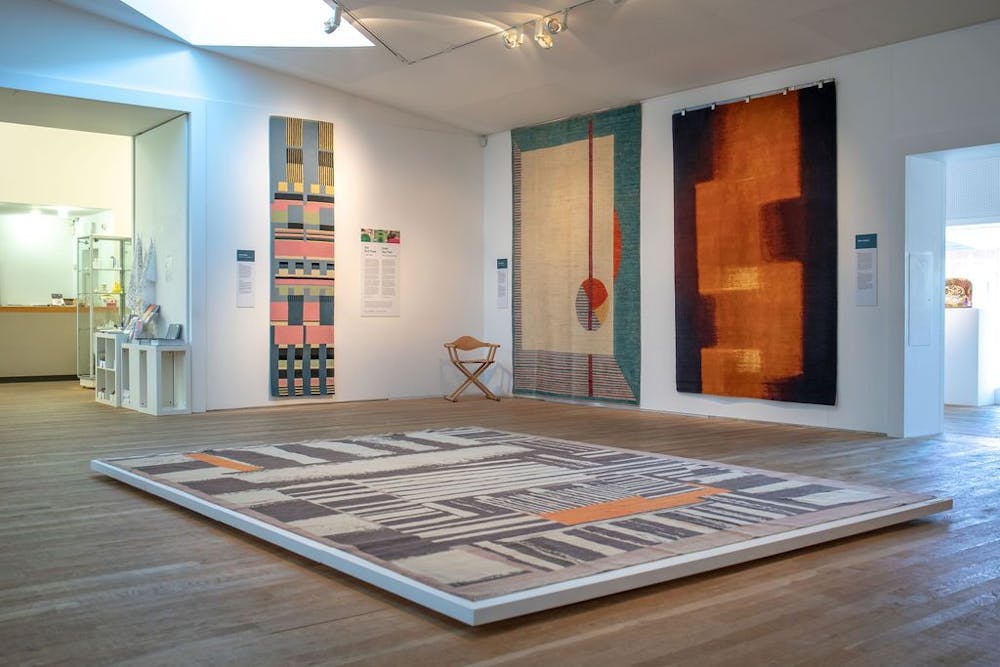
Under Your Feet exhibition view, photo by Stephen Heaton.
Like opera, that combines music, theatrics, libretto and staging, rugs work similarly on many different levels – design, colour, texture and size. Not only can they be physically substantial, heavy objects, they convey character and mood through their texture and colour/colour-combinations, be it bold or muted, abstract or irregular forms or following a repeated pattern or rhythm. All of these elements contribute to the influence a rug can have on the atmosphere of the space it is in.
“A rug is a large presence within a room,” say co-curators Gregory Parsons and Jane Audas. “It brings texture, colour, design and wit to an interior, where it will focus the eye and comfort the feet. Depending on the rug, it might pull together an overall interior aesthetic, or provide a significant visual exclamation point for an otherwise quiet room.”

On the left a rug by Irene Infantes for Christopher Farr Rug and on the right a Ptolemy Mann rug, photos by Stephen Heaton
On display alongside the stunning, and often brightly coloured, work in this exhibition is our Black/Grey Milano Rug. It is a very graphic, almost minimalist piece, based on two alternating textures – unspun twisted fleece and spun woollen yarn. The unspun fleece offers a tactile quality, an organic feel close to its natural origins. Twisted into a linen warp the unspun fleece provides great depth of character and texture.
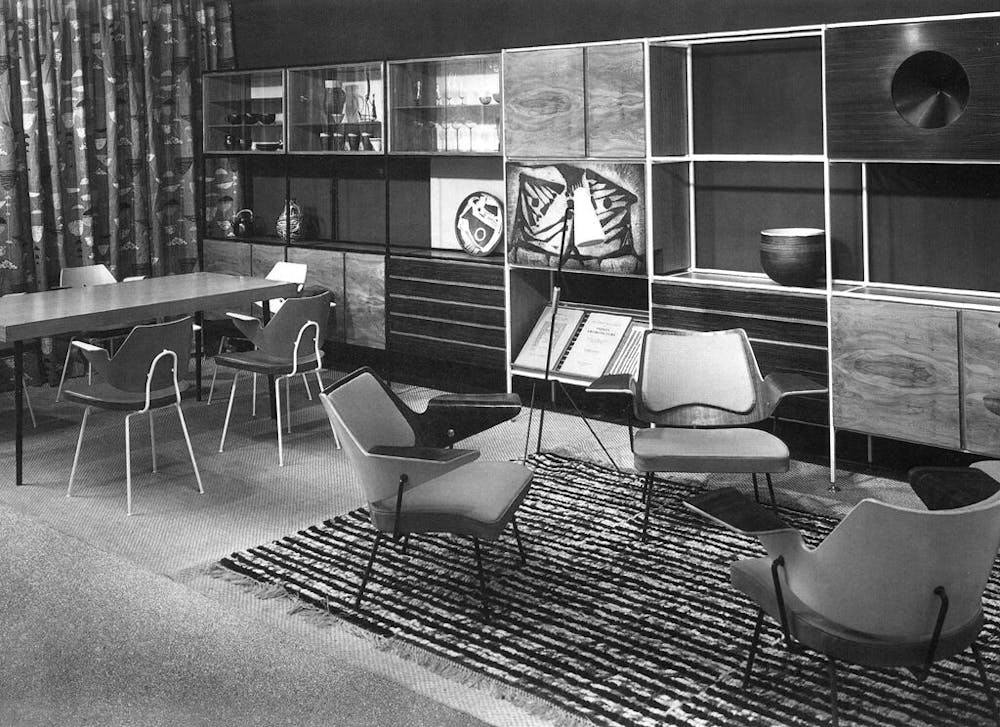
The Milano Rug on display with Robin Day's furniture at the 1951 Triennale di Milan, photo Mourne Textiles.
Mourne Textile’s founder Gerd Hay-Edie, and designer of the Milano Rug, was a long-time collaborator with furniture designer Robin Day, who, in 1950 was looking for a particular rug to position alongside his furniture display for the 1951 Triennale di Milano. Day said of the Milano Rug, “Of all the rugs which I have seen, only yours have got the character enough as a background for my new designs of furniture…”
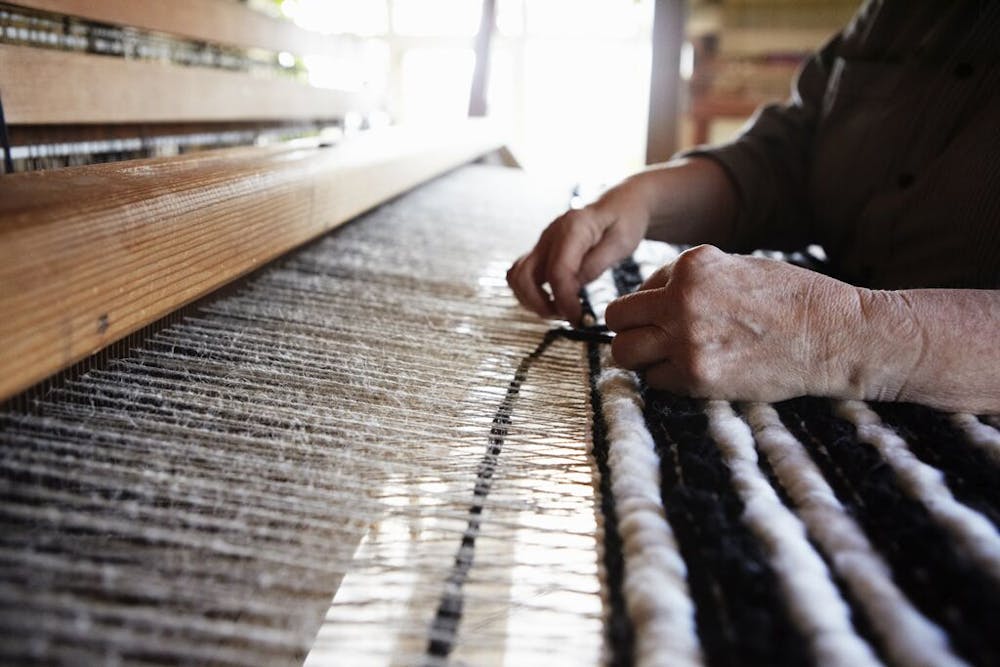
Milano Rug on the loom, the yarn is wrapped around wooden sticks to create a looped texture. Having spent time in Asia, designer Gerd Hay-Edie origianlly used chopsticks for this part of the process, photo by Tara Fisher.
Often a meticulously finished piece belies the technical challenges or the time taken to product it. One Milano Rug takes several weeks to complete and requires specialist techniques to achieve several aspects of the design. To keep the rug in production into the future these skills are being nurtured in a new generation of apprentice weavers who are currently learning these techniques.
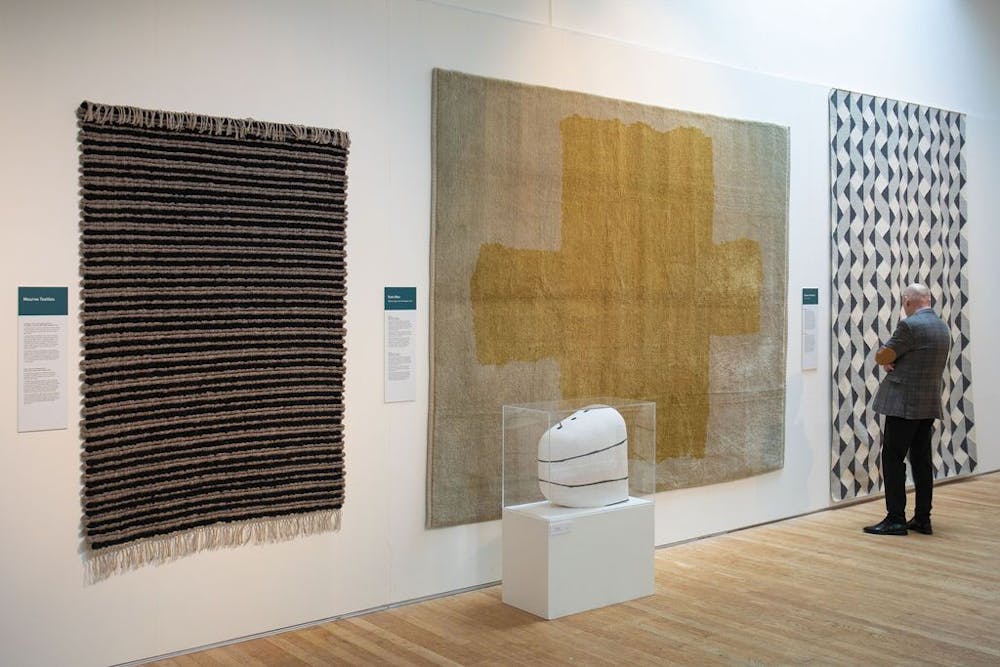
Under Your Feet exhibition view, photo by Stephen Heaton.
The rugs in this exhibition represent a wide range of techniques and approaches to the form. Some rugs are made from start to finish by designer-makers, whereas for others design and production are separated out. They are all underpinned by a strong ethical starting point in terms of the materials they use and the high working standards of the people producing them. Curator Gregory Parsons adds: “It was really important that the work in the exhibition had integrity in its concept, design and making. We have also been aware of the ‘fair trade’ nature of the rug making: those pieces designed in the UK and made overseas were to be fully part of responsible trading schemes whereby workers are of an appropriate age, paid a proper wage and work in good conditions.”
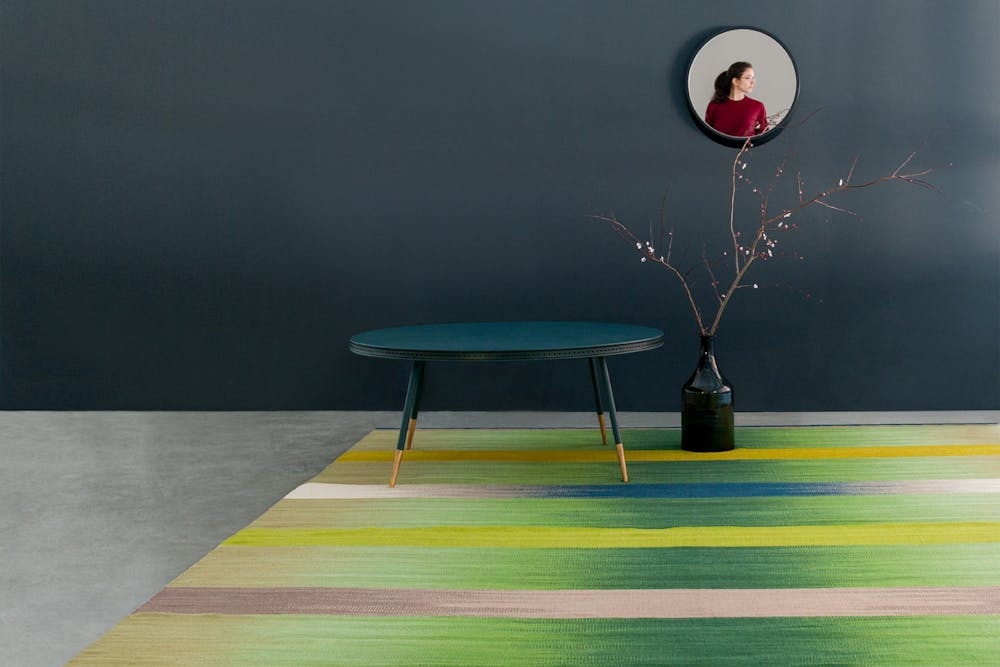
Ptolemy Mann with a table by Bethan Grey
A good illustration of this are Ptolemy Mann’s colourful rugs, following her signature colour-blending designs, that are made by master dyers and weavers in India and Nepal whose employers are members of Goodweave, a non-profit organisation whose mission is to bring transparency to global supply chains and end child labour. Key to the success of Mann’s production is the long-lasting and close working relationships she has with her masterweavers despite the distance.
While this exhibition’s focus is on the contemporary rug, it is interesting to look back at how long humans have been using rugs and for what purposes. One of the oldest known rugs dates from around the 5th century BCE, found in the grave of a nobleman in Kazakhstan. This rug, like so many rugs from the near, middle and far east, tells stories of its owner through imagery of the natural world and the accoutrements of an important person. Not purely for a practical use – like a Rya rug from Scandinavia that was used as an alternative to fur and offered insulation and comfort as a bed cover - over the centuries much weight was given to ornamental rugs and their visual effects, that often illustrated stories, and were valuable for many reasons, including the many precious threads woven into the mix.
A visit to the Oriental Rug Department in Liberty, London will fill you with awe at the immense craftsmanship involved in producing such a piece and the unique presence and individual character that each one has - most can be traced back to certain villages and tribes through their signature designs. If you ever find yourself nearby and are able to pop in you will enter an other-worldly grotto-like room, with colourful carpets and rugs lining the walls and hanging from the ceiling and waist-high stacks of antique, old and newly hand-woven rugs piled one top of one other.
We hope you can make to this unique exhibition Under Your Feet to celebrate the form of the rug as well as to appreciate the quality of contemporary craftsmanship and design currently alive in the British Isles.
Under Your Feet: The Contemporary Rug is on at Ruthin Craft Centre until 14 July 2019.
The exhibition features the following makers and designers: Lesley Barnes for Node, Kate Blee for Christopher Farr, Claire Gaudion, Adam Higton, Irene Infantes for Christopher Farr, Tania Johnson, Andrew Ludick for Ceadogán Rugmakers, Ptolemy Mann Rugs, Mourne Textiles, Patricia Murphy for Ceadogán Rugmakers, Alan Oliver, Angie Parker, Eleanor Pritchard for CASE, Rachel Scott, Margo Selby, Helen Steele for Ceadogán Rugmakers, Gunta Stölzl by Christopher Farr, Collett-Zarzycki for Christopher Farr and Helen Yardley.